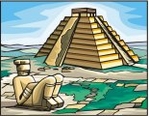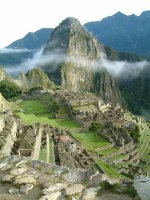
Worksheets and No Prep Teaching Resources
Reading Comprehension Worksheets
Ancient America

Ancient America
 Worksheets and No Prep Teaching Resources Reading Comprehension Worksheets Ancient America |
 Ancient America |
| edHelper's suggested reading level: | grades 9 to 12 | |
| Flesch-Kincaid grade level: | 10.1 |
|
Machu Picchu
By Vickie Chao |

|
 1 July 24, 1911, might have been an ordinary day for most people. But it was definitely not so for Yale University Professor Hiram Bingham because it was on that day that he "discovered" Machu Picchu -- the lost city of the Incas. Technically speaking, Machu Picchu was not a big secret to the locals, and Professor Bingham did not really "discover" it all by himself. Truth be told, he was accompanied by a farmer named Melchor Arteaga who knew his way around the Andes Mountains. After trekking for nearly a day, the two finally reached the mountaintop of Machu Picchu. When Professor Bingham saw the Inca ruin before him, he knew that he had just stumbled upon something very important. Though he was certainly not the first person in modern history to actually find it, he was indeed the first outsider who visited it. After he came back, he wrote a bestselling book titled The Lost City of the Incas and introduced Machu Picchu to the rest of the world. From that point on, this once elusive site has simply become one of the most popular tourist destinations in South America!
1 July 24, 1911, might have been an ordinary day for most people. But it was definitely not so for Yale University Professor Hiram Bingham because it was on that day that he "discovered" Machu Picchu -- the lost city of the Incas. Technically speaking, Machu Picchu was not a big secret to the locals, and Professor Bingham did not really "discover" it all by himself. Truth be told, he was accompanied by a farmer named Melchor Arteaga who knew his way around the Andes Mountains. After trekking for nearly a day, the two finally reached the mountaintop of Machu Picchu. When Professor Bingham saw the Inca ruin before him, he knew that he had just stumbled upon something very important. Though he was certainly not the first person in modern history to actually find it, he was indeed the first outsider who visited it. After he came back, he wrote a bestselling book titled The Lost City of the Incas and introduced Machu Picchu to the rest of the world. From that point on, this once elusive site has simply become one of the most popular tourist destinations in South America! |
Create Weekly Reading Books
Prepare for an entire week at once! |
| Leave your feedback on Machu Picchu (use this link if you found an error in the story) |
 |
Ancient America
|
 |
High School Reading Comprehensions and High School Reading Lessons
|
 |
Social Studies
|